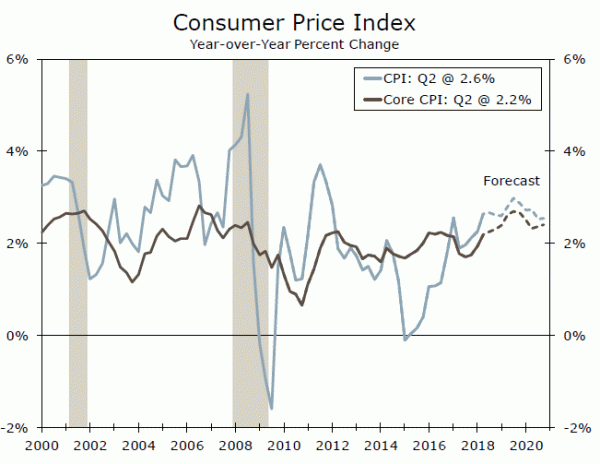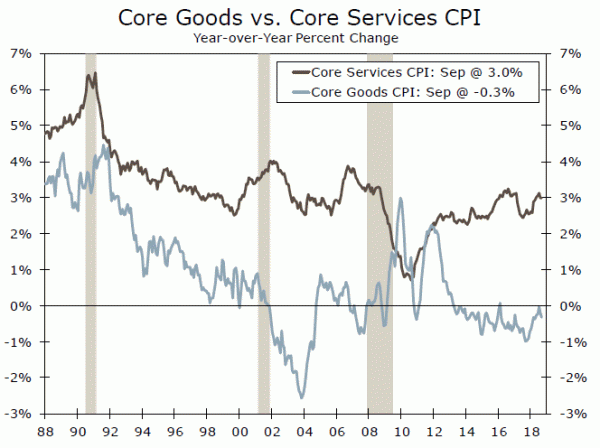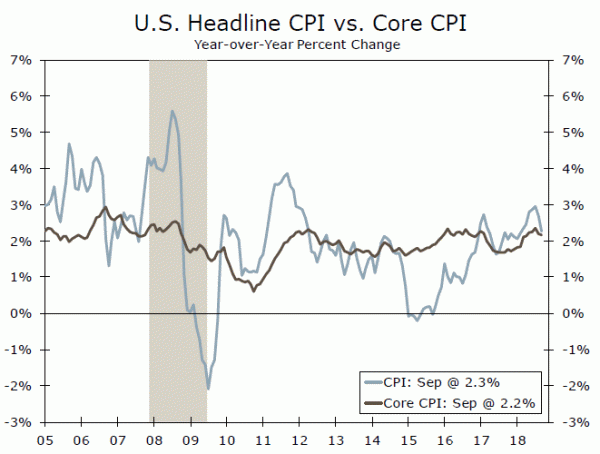CPI came in soft in September with headline and core inflation each advancing 0.1%. Nevertheless, inflation pressures are building. With higher oil prices and tariffs, we have raised our outlook for inflation.
CPI Soft, But Not the Start of a Trend
Consumer price inflation came in more tepid than expected, increasing 0.1% in September. Headline inflation was weighed down by a 0.5% drop in energy prices, which largely stemmed from a pullback in costs for electricity and utility gas service. Meanwhile, food costs were flat, as a 0.1% decline in grocery prices was offset by an increase in food away from home.
Core inflation also came in soft in September, printing 0.1% for a second consecutive month. Weakness can be traced to another drop in core goods. A 3.0% reduction in used auto prices led the decline, but with the Manheim used car index increasing in recent months and Hurricanes Florence and Michael likely to generate replacement demand, the pullback should be short-lived. Core services came in at a trend-like 0.24%.
Raising Our Inflation Forecast
Today’s soft readings may temper some concerns about rising price pressures as the economy continues to grow well-above potential. However, we believe inflation will strengthen in the months to come and have upwardly revised our inflation forecast. We look for the Consumer Price Index to rebound to 2.6% year-over-year in the fourth quarter before climbing to 2.8% in 2019 (2.5% previously).
The sources of the lift are two-fold. First, supply/transportation constraints point to higher oil prices through the remainder of this year and into next than we had previously expected. Second, tariffs on U.S. imports have broadened to where we now expect them to have a noticeable impact on the aggregate price level. The initial rounds of tariffs primarily concentrated on intermediate products (e.g., steel and aluminum), but with $200 billion of imports from China now subject to tariffs, finished consumer goods are increasingly in the crosshairs.
Given that many businesses already have price contracts in place or may absorb some of the costs, the impact of tariffs is likely to be drawn out. We expect to see tariffs push up consumer prices in the final months of the year as well as the first few months of 2019. With capacity already tight, some businesses may find it easier to pass on higher input costs to their customers under the guise of tariffs. At the same time, tougher profit comparisons early in 2019 (following the corporate tax cuts) could lead companies to raise prices in order to mitigate a likely slowdown in corporate profits.
While we expect inflation to be stronger in 2019, we have left our fed funds rate call unchanged. We continue to look for the FOMC to raise rates 25 bps per quarter through the third of quarter of 2019. With the lift in inflation stemming from oil and tariffs (which provide a one-time upward level shift in prices), we anticipate the Fed will likely look through the pickup. If, however, inflation expectations break above their ranges of the current expansion, the FOMC’s response to higher inflation could change.
















